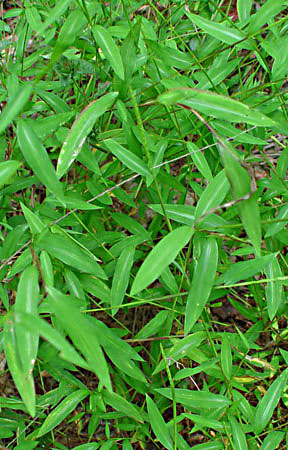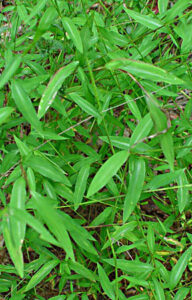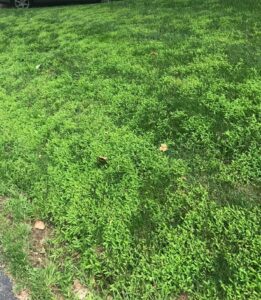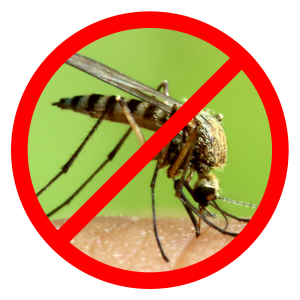Japanese Stiltgrass

Japanese stiltgrass is an invasive summer annual that is troublesome for many homeowners, especially those whose properties are adjacent to wooded areas. Although this weed may be difficult to control and eradicate from residential lawns, this blog will walk you through why Japanese stiltgrass grows and how to go about controlling it.
About Japanese Stiltgrass
Japanese stiltgrass becomes active in late spring each year just before the far more infamous summer annual, crabgrass. Due to its creeping growth habit and low requirement for moisture and nutrients, it is highly adaptive and can spread across large areas. In wooded areas, it can blanket the entirety of the forest floor and can grow to three and a half feet in height.
From there, it can spread onto nearby residential lawns that may have shaded and thin turf and prove especially difficult to control. On a residential lawn kept at a 2”-3” mowing height, Japanese stiltgrass looks very similar to small bamboo shoots and can weave in and out of existing turf, forming dense, unsightly patches each summer. Not only does it contrast a great deal with the look of any desirable grass species in the lawn but being a summer annual, it will not persist beyond early fall. This leaves behind bare areas of exposed soil in its absence.
How to go about control
The decision on how to proceed with control measures depends on just how much of this weed exists on the property. If Japanese stiltgrass consists of most of your groundcover on your property, the best idea is to start with renovation seeding. Remember, Japanese stiltgrass is a summer annual, so it will die on its own once it becomes cooler heading into the fall. This means the lawn can be mechanically seeded with a slit seeder, core aerator, and/or dethatcher at the end of August.
In some cases, the weed cover may be too thick to seed through, especially if there are other weeds (and there usually are) in addition to the Japanese stiltgrass. If this is the case, it would be best to eliminate the worst portions of the lawn first using a non-selective weed and grass killer such as Roundup. This should be done around mid-August because seeding will have to be delayed 10-14 days following application of the herbicide.
Once the lawn has been established, or if you already had a pretty good lawn to begin with, steps must be taken to keep the Japanese stiltgrass from returning each year. Unlike the stiltgrass, desirable grasses used on home lawns require ample soil moisture and fertilization to grow vigorously enough to keep out invasive weed species. Keeping the lawn on a maintenance fertilizer program and promoting the growth of the grass will be the most important part of keeping out invasive weed species such as this one.
To gain more complete control over such an aggressor, use of herbicides will be necessary. Pre-emergent crabgrass control applications done each spring will help keep down some percentage of the Japanese stiltgrass. The control will not be as complete as it is for crabgrass, but the partial control it provides will be helpful. There are also selective herbicides that can be used to control whatever Japanese stiltgrass continues to come up in the summer. Treatments can be made to the lawn as necessary to suppress this weed while it is actively growing until the weather becomes cooler in the early fall and new growth ceases.
Conclusion
If you are struggling with Japanese stiltgrass on your property, the most important thing to keep in mind is that significant control takes time. To successfully control this weed we recommend establishing a thick lawn, then maintain the turf with a comprehensive fertilizer and weed control program each year. The biggest mistake homeowners make with this weed is trying to gain control with just a few selective applications in the summer, or having the lawn seeded without maintaining the turf.
When dealing with such a formidable issue such as Japanese stiltgrass, it is best to enlist the help of a professional lawn care company. A knowledgeable technician can walk you through the process of control step-by-step, as well as make any adjustments necessary to contend with other weed issues the lawn may develop. But even with professional help, the control will be progressive and can take years. Be patient and be persistent, and eventually you will develop the level of control you are looking for.
If you have questions about Japanese stiltgrass, and would like to speak to a licensed professional, please give our office a call at 908-281-7888, or request a free estimate online.






